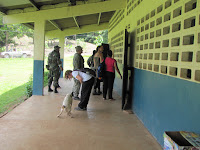What is inside your classroom? Other kids in your grade level? Desks and tables? Some computers? Cabinets? A sink? Boxes and boxes of books? Posters on the walls?
Now, think about what kinds of tools you use to learn. Do you use calculators? Rulers? Colored pencils? Computers? Is there a pencil sharpener- perhaps an electric one?
Some of the people who work on BCI have come from Las Pavas, a small community on the mainland near the island. The guardabosques who protect BCI also help out at the school from time to time. They teach the kids about what they do and why protecting the forest is important. They also give the kids in Las Pavas a Christmas party. The guardabosques thought we might be interested in seeing the school, so they invited us to visit.
On the day of our trip, we took a 20-minute boat ride from the island through part of Gatun Lake to the mainland to a peninsula called Gigante. Andrés, the guardabosque who took us tied the boat to a dock, and then we started to hike on a path in the woods. We walked through a large teak plantation. The owners of the plantation selectively harvest the trees and sell them to make furniture. The vast majority of what is growing there are teak trees - all of the native plants from the tropical forest have been cut down. Then we walked by some land that is being turned into a large farm – there were very few trees to be seen there. Along the road, we saw tiny houses with yards. The houses are very far apart. We walked and walked along the dirt road.
We finally saw a building with a red roof. We had finally made it to the school! As we approached, we saw that the school was simply a long rectangular building with a porch. There were three classrooms all in a row, right next to each other. There is no main office with a secretary to greet you. There is no principal. There are no electric pencil sharpeners or computers. There are merely three classrooms.

On the day we visited, one classroom was empty. That classroom is a kindergarten classroom. We don’t know where the kids were, but we were told that a mom from the village usually comes in to work with the little kids. The other two classrooms each have one teacher. One class is for first, second and third graders. The other classroom is for fourth, fifth and sixth graders. The entire school has 49 students and two teachers.
The classrooms have desks and a chalkboard. There are few posters on the walls. There is a desk for the teacher and 2 shelves with some things on them like glue and notebooks. There is no sink. There are no big boxes of books. There is no rug to sit on. Think about it: Desks, a chalkboard, and 2 shelves. That’s it.
The students at Las Pavas go to school from 8:00 a.m. to 12:00 or 1:00 p.m. They do not eat breakfast or lunch there. They do not have a gym or an art room. In addition to that, there is no school for the students in middle or high school! If they want to continue going to school past sixth grade, they have to walk for 2 hours to the next village. There are no school buses or city buses.
The biggest surprise for Ms. Sarah and me was the fact that the teachers live at the school! They each have one tiny cinderblock room. They live in that room from Sunday to Friday and then go home on the weekends to their families in other communities. There are no screens on the windows, so bugs and other small animals can get in. One teacher had been stung by a scorpion that crawled into her room! Recently, they told us, there was a snake in the yard. Yikes!
Can you see yourself going to school in Las Pavas? It is hard to imagine, isn’t it? Do you feel fortunate? I know that I do.






No comments:
Post a Comment